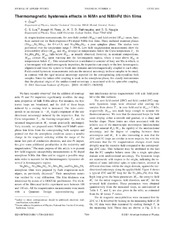| dc.description.abstract | dc magnetization measurements, for zero-field cooled (MZFC) and field-cooled (MFC) cases, have been carried out for flash-evaporated Pd-doped NiMn thin films. These included reentrant phases (Ni76xPdx)Mn24, for 0x5, and Ni75Mn23Pd2, a pure spinglass phase. The studies were performed over the temperature range 3–300 K. Low-field magnetization measurements show the irreversibility effect (MZFC and MFC diverge at temperatures below the Curie temperature Tc . In Ni75Mn23Pd2, MZFC falls below MFC, as usually observed. However, in reentrant compositions, M ZFC crosses M FC upon warming into the ferromagnetic regime, where it stays above M FC at temperatures below Tc . This unusual behavior is attributed to a model of Imry and Ma in which, in a ferromagnet with antiferromagnetic impurities, the impurities can couple to the host ferromagnetic alignment and force the system to break into domains antiferromagnetically coupled to each other. Field-cooled hysteresis measurements indicate the uniaxial anisotropy in these samples to be small, in contrast with the rigid uniaxial anisotropy reported for the corresponding polycrystalline bulk samples. Since the lattice-orbit coupling is weak in the amorphous phase, this clearly demonstrates that the physical origin of the unidirectional anisotropy is associated with the spin-orbit coupling. | en |


